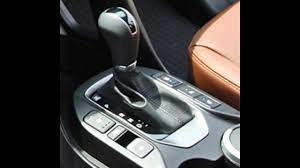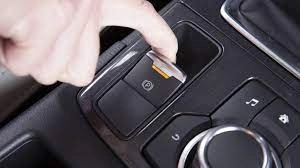Many of us face the problem of skidding and sudden accidents when in the car, whether it's due to wet roads or sharp bends in the road. The Electronic Parking Brake (EPB) addresses the issue of skidding and sudden accidents, providing a high level of safety for car passengers.
So we will learn about the electronic handbrake, also known as the electric parking brake, and how it can improve your safety on the road. We will discuss how these brakes work, and what are the advantages and disadvantages that they possess.

What is the electronic brake?
Electric parking brakes differ from traditional handbrakes in that they use an electrical system instead of cables to tighten the brakes. This means they use electric motors to apply the brakes instead of manual force.
The electric brakes control the system.The BrakesUsing an electronic control unit called "Electric Brake Control Module".
Electric parking brakes prevent the car from moving when it is stopped, and ensure that it does not move when it is parked. They can easily be activated via a button or switch on the dashboard. The electric brake automatically disengages when the car accelerates and automatically applies when the gas pedal is pressed.
Furthermore, the electronic handbrake requires much less maintenance than the traditional handbrake, as the mechanical parts get damaged much less and withstand wear and tear far better. It can also help to reduce the weight of the car and improve fuel consumption efficiency.
Electric parking brakes are usually installed on luxury and sports cars, but they have increasingly become common in other cars in recent years.
How does the electronic brake work?
In the electric parking brake system, braking is controlled by an electronic brake unit and an electric motor instead of the traditional manual brake cable.
The electronic brake unit interacts with sensors in the car, which determine whether the car is stationary or not, and controls the operation of the electric motor installed in the rear brakes.
When the brakes are applied, the electronic brake unit activates the electric motor installed in the rear brakes and presses the pads against the discs to ensure that the car does not move.
The brakes are operated by an electrical switch in the cabin, and can be deactivated by pressing the gas pedal. The Hill Start Assist function is integrated with some electronic brake systems, which helps to prevent the car from moving backward or forward when the driver starts driving on an inclined surface.
The system is characterized by the absence of mechanical connections, thus, it operates instantly and efficiently, improving the overall reliability of braking. It also allows for saving space in the cabin by eliminating the traditional handbrake cable.
Also read: Maintaining Car Tires: 6 Different Methods

Features of the Electronic Brake System
The Electric Parking Brake (EPB) offers numerous advantages over traditional brakes, including:
Improving Safety
The safety enhancement feature in Electric Parking Brakes (EPB) means that they operate more precisely and efficiently, contributing to improved safety and security when using the brakes. These brakes activate more quickly and accurately, with the ability to distribute braking force more effectively on the wheels, thus avoiding skidding or sliding.
This means that the driver can control the car more safely, especially in emergency situations like skidding on highways or wet or icy roads. This helps to prevent accidents and protect the driver and passengers.
Saving Space
The electronic handbrake relies on electric braking technology instead of the classic brakes that rely on friction between drums and discs. Because of this design, electric brakes do not need the presence of the classic parking brakes, which rely on a mechanical system to ensure the car does not move when it is stationary.
Since electric brakes do not require this mechanical system, they provide extra space inside the car that was previously designated for parking brakes.
Thus, the use of space inside the car is improved, and the additional space can be used for other purposes such as the back seats or storage areas.
Ease of use
The electric parking brakes can be easily controlled by a button or pulling a lever, which means that the driver will not need to use extra physical force to operate the brakes as in traditional brakes.
Better Control
Thanks to electric brake technology, the driver can have better control over the braking distance and strength. This allows them to better control the vehicle in poor weather conditions or on steeply sloped roads.

Flaws of the Electronic Brake System
Although EPB brakes offer numerous advantages, they are not without some drawbacks, including:
The cost of repairing or replacing an electronic braking system in case of damage is much higher compared to traditional brakes.
2- The EPB brakes can sometimes make it difficult to control the car when in contact with a steeply inclined surface, causing the car to rise significantly and move forwards or backwards unexpectedly.
3- Loss of motion inElectronic handbrake(Electronic Parking Brake) EPB, if the brakes are not working properly or when the speeds are high, this can result in a loss of motion in the car, which increases the risk of an accident. This problem can occur due to different factors, such as uncontrollable circumstances like unsuitable roads.

Comments